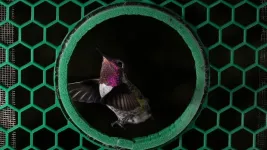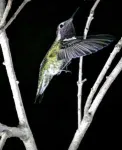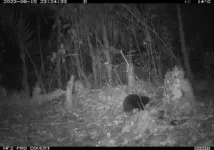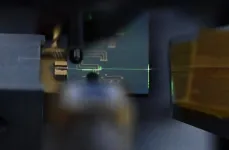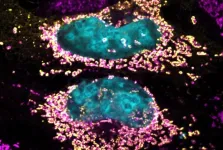(Press-News.org) Most birds that flit through dense, leafy forests have a strategy for maneuvering through tight windows in the vegetation — they bend their wings at the wrist or elbow and barrel through.
But hummingbirds can't bend their wing bones during flight, so how do they transit the gaps between leaves and tangled branches?
A study published today in the Journal of Experimental Biology shows that hummingbirds have evolved their own unique strategies — two of them, in fact. These strategies have not been reported before, likely because hummers maneuver too quickly for the human eye to see.
For slit-like gaps too narrow to accommodate their wingspan, they scooch sideways through the slit, flapping their wings continually so as not to lose height.
For smaller holes — or if the birds are already familiar with what awaits them on the other side — they tuck their wings and coast through, resuming flapping once clear.
"For us, going into the experiments, the tuck and glide would have been the default. How else could they get through?" said Robert Dudley, a professor of integrative biology at the University of California, Berkeley, and senior author of the paper. "This concept of sideways motion with a total mix-up of the wing kinematics is quite amazing — it's a novel and unexpected method of aperture transit. They're changing the amplitude of the wing beats so that they're not dropping vertically when they do the sideways scooch."
Using the slower sideways scooch technique may allow birds to better assess upcoming obstacles and voids, thereby reducing the likelihood of collisions.
"Learning more about how animals negotiate obstacles and other 'building-blocks' of the environment, such as wind gusts or turbulent regions, can improve our overall understanding of animal locomotion in complex environments," noted first author Marc Badger, who obtained his Ph..D from UC Berkeley in 2016. "We still don't know very much about how flight through clutter might be limited by geometric, aerodynamic, sensory, metabolic or structural processes. Even behavioral limitations could arise from longer-term effects, such as wear and tear on the body, as hinted at by the shift in aperture negotiation technique we observed in our study."
Understanding the strategies that birds use to maneuver through a cluttered environment may eventually help engineers design drones that better navigate complex environments, he noted.
"Current remote control quadrotors can outperform most birds in open space across most metrics of performance. So is there any reason to continue learning from nature?" said Badger. "Yes. I think it's in how animals interact with complex environments. If we put a bird's brain inside a quadrotor, would the cyborg bird or a normal bird be better at flying through a dense forest in the wind? There may be many sensory and physical advantages to flapping wings in turbulent or cluttered environments."
Obstacle course
To discover how hummingbirds — in this case, four local Anna’s hummingbirds (Calypte anna) — slip through tiny openings, despite being unable to fold their wings, Badger and Dudley teamed up with UC Berkeley students Kathryn McClain, Ashley Smiley and Jessica Ye.
"We set up a two-sided flight arena and wondered how to train birds to fly through a 16-square- centimeter gap in the partition separating the two sides," Badger said, noting that the hummingbirds have a wingspan of about 12 centimeters (4 3/4 inches). "Then, Kathryn had the amazing idea to use alternating rewards."
That is, the team placed flower-shaped feeders containing a sip of sugar solution on both sides of the partition, but only remotely refilled the feeders after the bird had visited the opposite feeder. This encouraged the birds to continually flit between the two feeders through the aperture.
The researchers then varied the shape of the aperture, from oval to circular, ranging in height, width and diameter, from 12 cm to 6 cm, and filmed the birds’ maneuvers with high-speed cameras. Badger wrote a computer program to track the position of each bird’s bill and wing tips as it approached and passed through the aperture.
They discovered that as the birds approached the aperture, they often hovered briefly to assess it before travelling through sideways, reaching forward with one wing while sweeping the second wing back, fluttering their wings to support their weight as they passed through the aperture. They then swiveled their wings forward to continue on their way.
"The thing is, they have to still maintain weight support, which is derived from both wings, and then control the horizontal thrust, which is pushing it forward. And they're doing this with the right and left wing doing very peculiar things," Dudley said. "Once again, this is just one more example of how, when pushed in some experimental situation, we can elicit control features that we don't see in just a standard hovering hummingbird."
Alternatively, the birds swept their wings back and pinned them to their bodies, shooting through — beak first, like a bullet — before sweeping the wings forward and resuming flapping once safely through.
"They seem to do the faster method, the ballistic buzz-through, when they get more acquainted with the system," Dudley said.
Only when approaching the smallest apertures, which were half a wingspan wide, would the birds automatically resort to the tuck and glide, even though they were unfamiliar with the setup.
The team pointed out that only about 8% of the birds clipped their wings as they passed through the partition, although one experienced a major collision. Even then, the bird recovered quickly before successfully reattempting the maneuver and going on its way.
"The ability to pick among several obstacle negotiation strategies can allow animals to reliably squeeze through tight gaps and recover from mistakes," Badger noted.
Dudley hopes to conduct further experiments, perhaps with a sequence of different apertures, to determine how birds navigate multiple obstacles.
The work was funded primarily by a CiBER-IGERT grant from the National Science Foundation (DGE-0903711).
END
Hummingbirds' unique sideways flutter gets them through small apertures
High-speed video reveals strategies hummingbirds use to transit apertures too small for their wingspan
2023-11-10
ELSE PRESS RELEASES FROM THIS DATE:
National analysis suggests that potentially serious complications occur in 1 in 18 procedures under the care of an anaesthetist
2023-11-10
New survey data from the 7th National Audit Project of the Royal College of Anaesthetists (NAP7) published in Anaesthesia (the journal of the Association of Anaesthetists) shows that potentially serious complications occur in one in 18 procedures under the care of an anaesthetist.
The risk factors associated with these potentially serious complications include very young age (babies); comorbidities; being male; increased frailty; the urgency and extent of surgery; and surgery taking place at night and/or at weekends.
This paper has been produced by a team of authors across ...
Study finds that laser epilation reduces risk of recurrence of pilonidal disease
2023-11-09
Laser epilation, commonly known as laser hair removal, reduced the risk of recurrence in patients with pilonidal disease, an inflammatory, painful, and sometimes chronic or recurring condition, according to research conducted by Peter C. Minneci, M.D., Chair of Surgery at Nemours Children’s Health, Delaware Valley, and published in JAMA Surgery.
Pilonidal disease occurs when cysts form between the buttocks. It is believed to be an inflammatory reaction to hair or debris that gets caught in the crease of the buttocks. The disease occurs in 26 to 100 per 100,000 people and is most common in adolescents and young ...
The U.S. Supreme Court restricted abortion rights and public support for abortion increased
2023-11-09
A new study examining the effects of the U.S. Supreme Court ruling on Dobbs v. Jackson Women's Health Organization on June 24, 2022, which overturned Roe v. Wade's constitutional protection of abortion rights, finds that the American public's support for abortion increased after the decision.
The findings were published today in Nature Behaviour.
"Our results show the extent to which the Supreme Court is out of step with the American public," says co-author Sean Westwood, an associate professor of government at Dartmouth and director of the Polarization Research Lab.
The study's findings were based on a large, three-wave survey before the leak ...
New evidence that heightened pain sensitivity is linked to sympathy for opposing political views
2023-11-09
The next time your friend displays remarkable openness to their opposite political camp’s ideas, you might try pinching them.
Okay, we don’t really recommend that. But new evidence shows that people with increased sensitivity to pain are also more likely to endorse values more common to people of their opposite political persuasion. It doesn’t stop there. They also show stronger support for the other camp’s politicians, and, get this -- more likely to vote for Donald Trump in 2020 if they are liberal, or Joe Biden if they are conservative.
Even ...
C-Path’s pioneering neuroscience workshop transforms the landscape of neurological disorder therapies
2023-11-09
Critical Path Institute (C-Path) is pleased to announce the release of a new peer-reviewed publication, titled “Transforming Drug Development for Neurological Disorders: Proceedings from a Multi-disease Area Workshop,” now published in Neurotherapeutics, The Journal of the American Society for Experimental Neurotherapeutics.
A distinguished team of C-Path scientists and patient-advocates spearheaded by Diane Stephenson, Ph.D., C-Path’s Executive Director of the Critical Path for Parkinson’s Consortium (CPP), has presented its learnings from C-Path’s 2022 Neuroscience Program Annual Workshop. The publication can be accessed in its entirety here.
Neurological ...
How to use AI for discovery — without leading science astray
2023-11-09
Over the past decade, AI has permeated nearly every corner of science: Machine learning models have been used to predict protein structures, estimate the fraction of the Amazon rainforest that has been lost to deforestation and even classify faraway galaxies that might be home to exoplanets.
But while AI can be used to speed scientific discovery — helping researchers make predictions about phenomena that may be difficult or costly to study in the real world — it can also lead scientists astray. In the same way that chatbots sometimes “hallucinate,” ...
Ultrafast lasers on ultra-tiny chips
2023-11-09
Lasers have become relatively commonplace in everyday life, but they have many uses outside of providing light shows at raves and scanning barcodes on groceries. Lasers are also of great importance in telecommunications and computing as well as biology, chemistry, and physics research.
In those latter applications, lasers that can emit extremely short pulses—those on the order of one-trillionth of a second (one picosecond) or shorter—are especially useful. Using lasers operating on such small timescales, researchers can study physical and chemical ...
Pesticides, herbicides, fungicides detected in New York state beeswax
2023-11-09
An analysis of beeswax in managed honeybee hives in New York found a wide variety of pesticide, herbicide and fungicide residues – exposing current and future generations of bees to long-term toxicity.
The study, published in the Journal of Veterinary Diagnostic Investigation, notes that people may be similarly exposed through contaminated honey, pollen and wax in cosmetics. Though the chemicals found in wax are not beneficial to humans, the small amounts in these products are unlikely to ...
Study reveals bacterial protein capable of keeping human cells healthy
2023-11-09
Researchers at the University of São Paulo (USP) in Brazil, partnering with colleagues in Australia, have identified a novel bacterial protein that can keep human cells healthy even when the cells have a heavy bacterial burden. The discovery could lead to new treatments for a wide array of diseases relating to mitochondrial dysfunction, such as cancer and auto-immune disorders. Mitochondria are organelles that supply most of the chemical energy needed to power cells’ biochemical reactions.
An article on the study is published in the journal PNAS. The researchers ...
Endangered thick-billed parrots at risk of losing newly identified, unprotected Sierra Madre forest habitats to logging, deforestation, study shows
2023-11-09
DOWNLOAD PHOTOS AND VIDEO: https://sandiegozoo.box.com/s/x50kzaoukdtyjxsv9mzqgn0fu1m6kddk
A binational team of scientists, using creativity and innovation, adorned dozens of endangered thick-billed parrots with tiny solar-powered satellite transmitters to track and reveal their winter migratory nesting sites in the remote treetops of the Sierra Madre Occidental ranges. Their research reveals new critical habitat, 80% of which has no formal protection.
In a study published this month in the journal Global ...
LAST 30 PRESS RELEASES:
The Lancet Obstetrics, Gynecology, & Women’s Health: Taking paracetamol during pregnancy does not increase risk of autism, ADHD or intellectual disabilities, confirms new gold-standard evidence review
Taking paracetamol during pregnancy does not increase risk of autism, ADHD or intellectual disabilities
Harm reduction vending machines in New York State expand access to overdose treatment and drug test strips, UB studies confirm
University of Phoenix releases white paper on Credit for Prior Learning as a catalyst for internal mobility and retention
Canada losing track of salmon health as climate and industrial threats mount
Molecular sieve-confined Pt-FeOx catalysts achieve highly efficient reversible hydrogen cycle of methylcyclohexane-toluene
Investment in farm productivity tools key to reducing greenhouse gas
New review highlights electrochemical pathways to recover uranium from wastewater and seawater
Hidden pollutants in shale gas development raise environmental concerns, new review finds
Discarded cigarette butts transformed into high performance energy storage materials
Researchers highlight role of alternative RNA splicing in schizophrenia
NTU Singapore scientists find new way to disarm antibiotic-resistant bacteria and restore healing in chronic wounds
Research suggests nationwide racial bias in media reporting on gun violence
Revealing the cell’s nanocourier at work
Health impacts of nursing home staffing
Public views about opioid overdose and people with opioid use disorder
Age-related changes in sperm DNA may play a role in autism risk
Ambitious model fails to explain near-death experiences, experts say
Multifaceted effects of inward foreign direct investment on new venture creation
Exploring mutations that spontaneously switch on a key brain cell receptor
Two-step genome editing enables the creation of full-length humanized mouse models
Pusan National University researchers develop light-activated tissue adhesive patch for rapid, watertight neurosurgical sealing
Study finds so-called super agers tend to have at least two key genetic advantages
Brain stimulation device cleared for ADHD in the US is overall safe but ineffective
Scientists discover natural ‘brake’ that could stop harmful inflammation
Tougher solid electrolyte advances long-sought lithium metal batteries
Experts provide policy roadmap to reduce dementia risk
New 3D imaging system could address limitations of MRI, CT and ultrasound
First-in-human drug trial lowers high blood fats
Decades of dredging are pushing the Dutch Western Scheldt Estuary beyond its ecological limits
[Press-News.org] Hummingbirds' unique sideways flutter gets them through small aperturesHigh-speed video reveals strategies hummingbirds use to transit apertures too small for their wingspan
